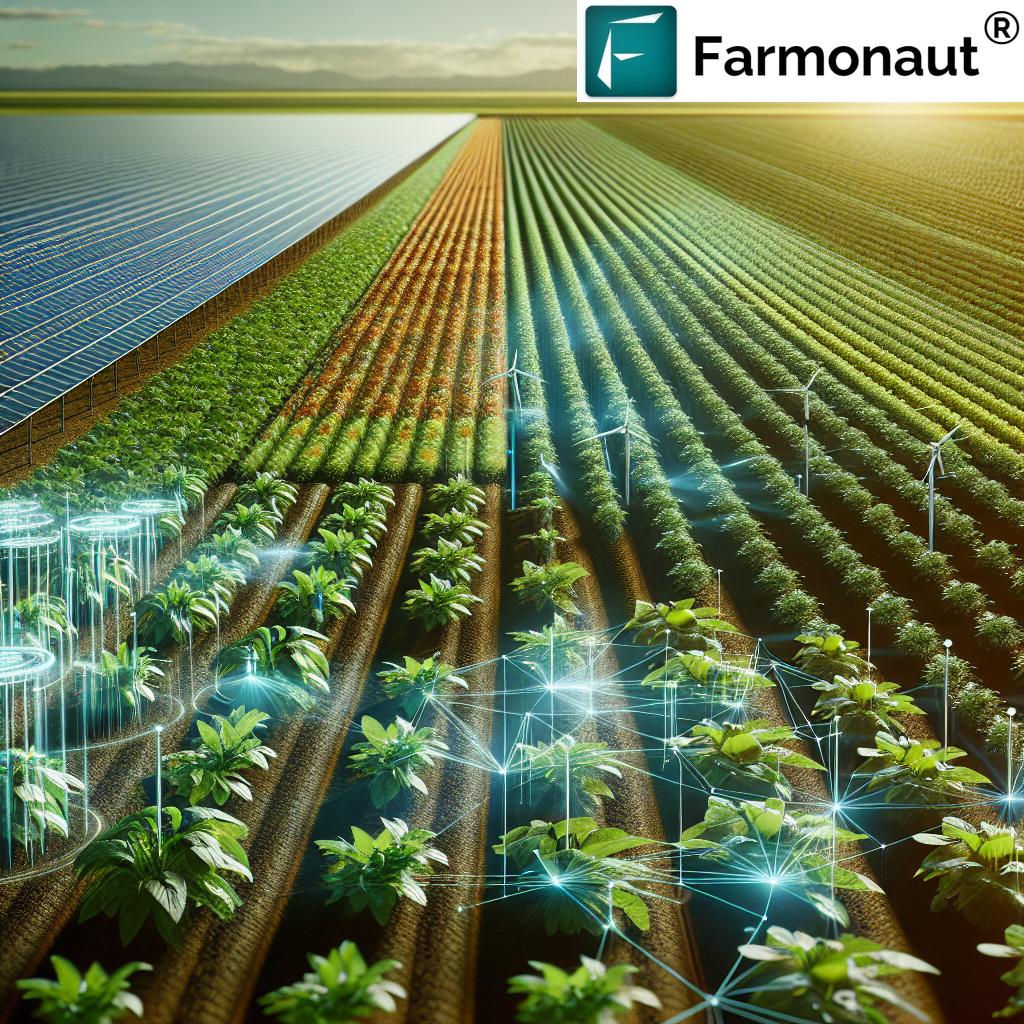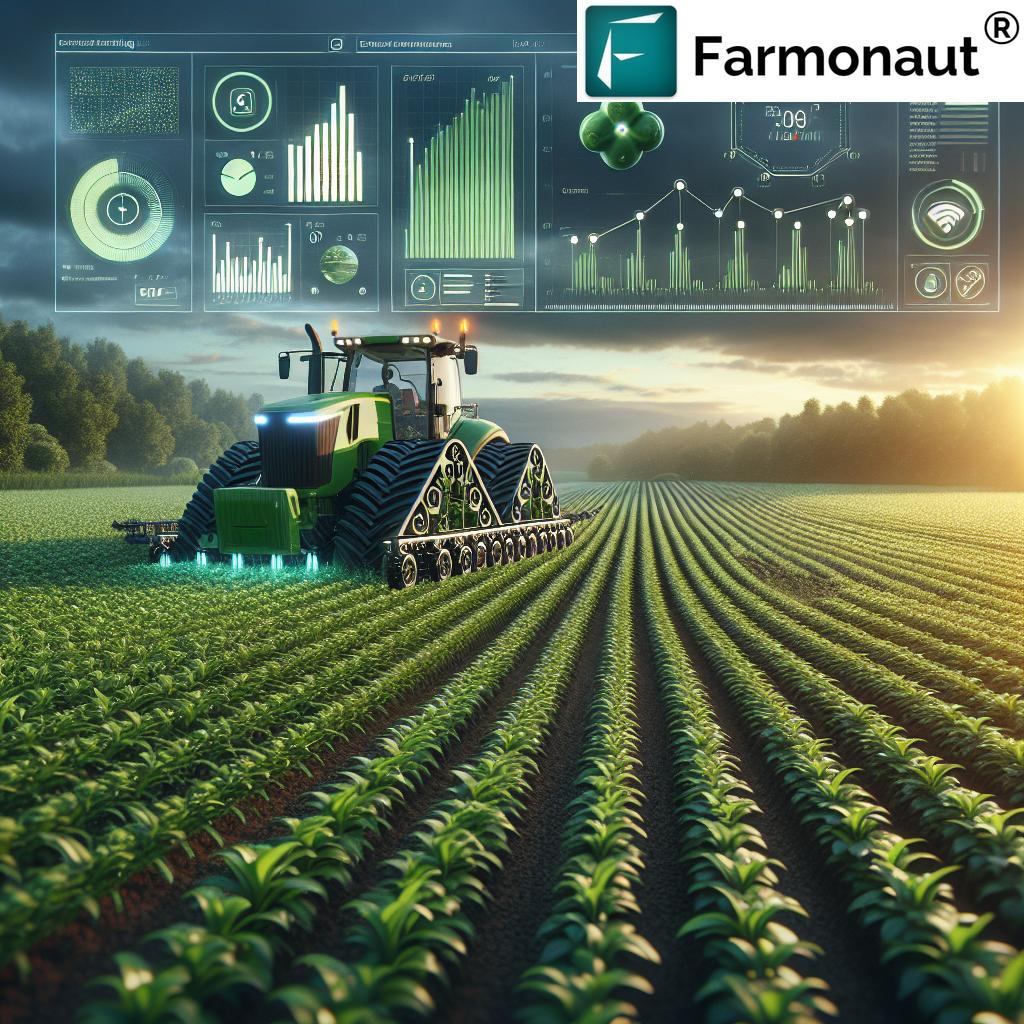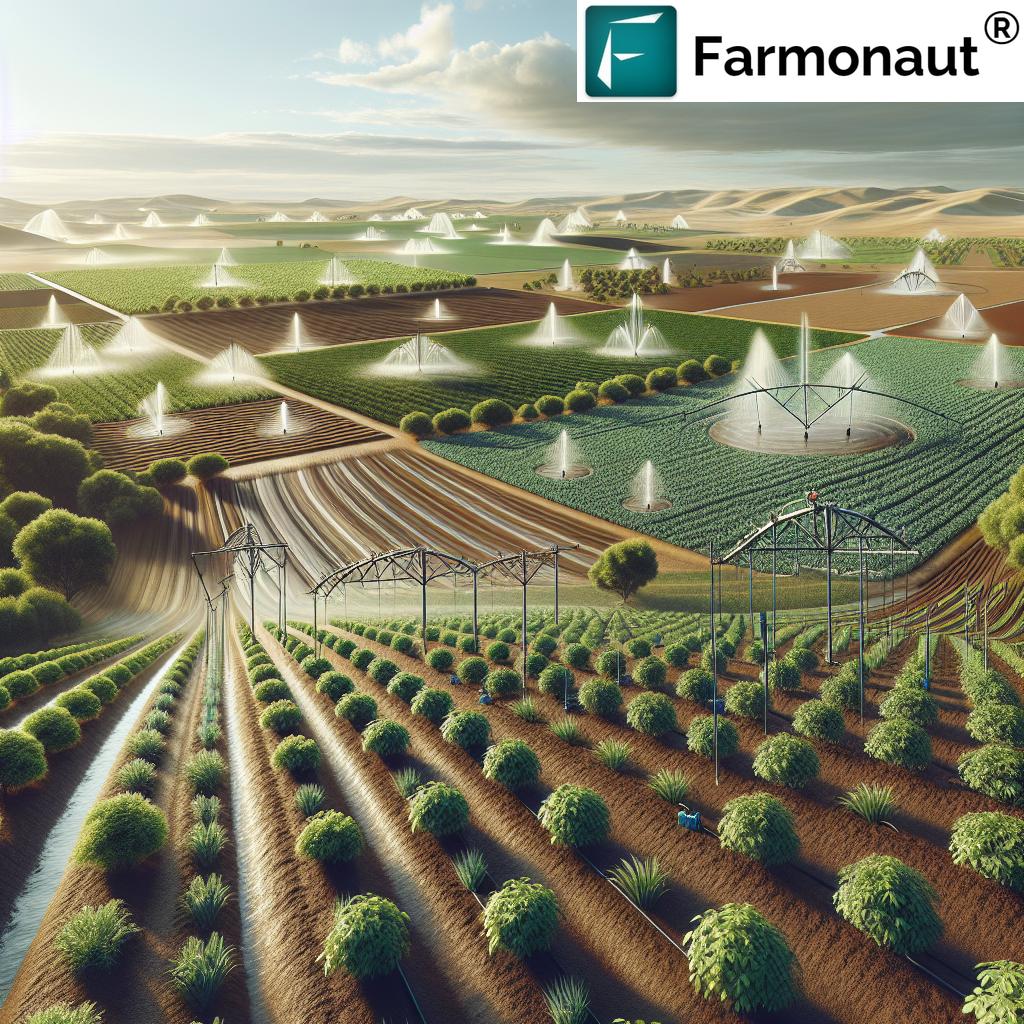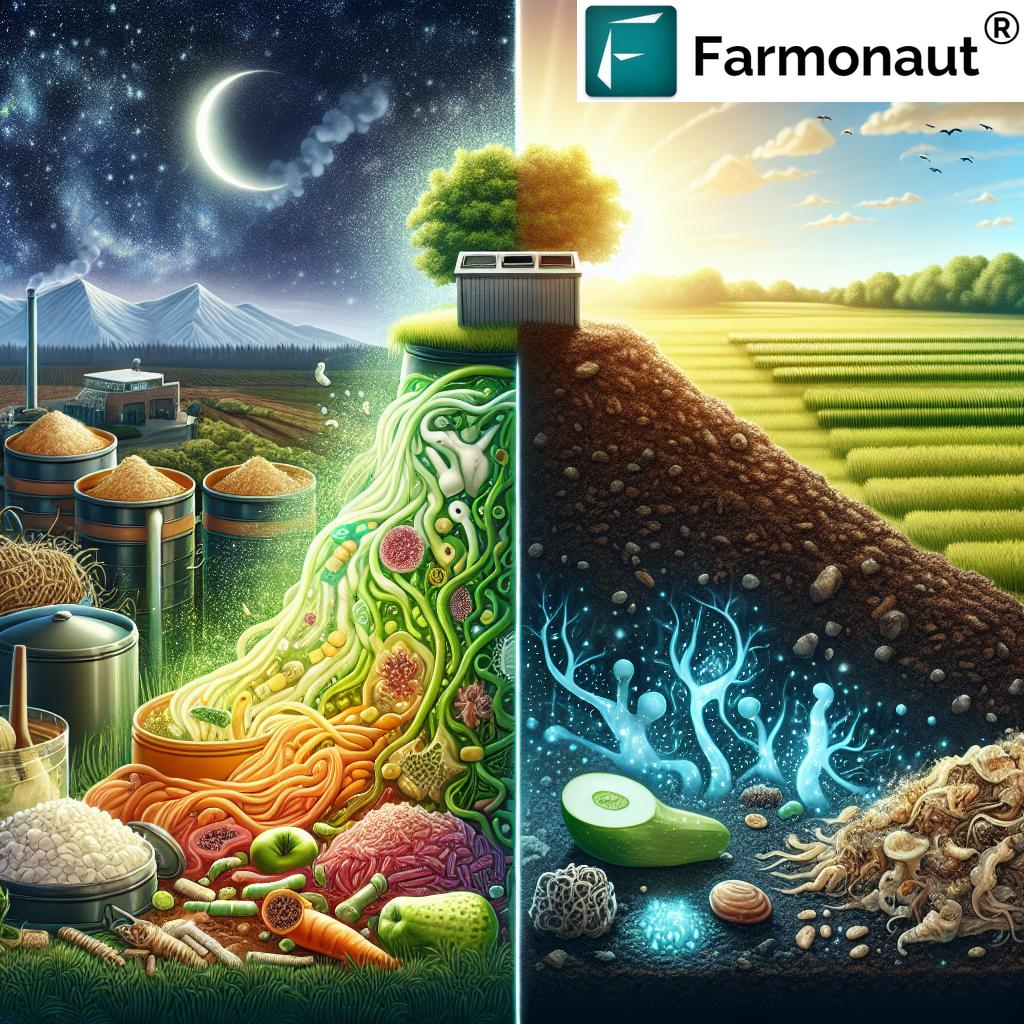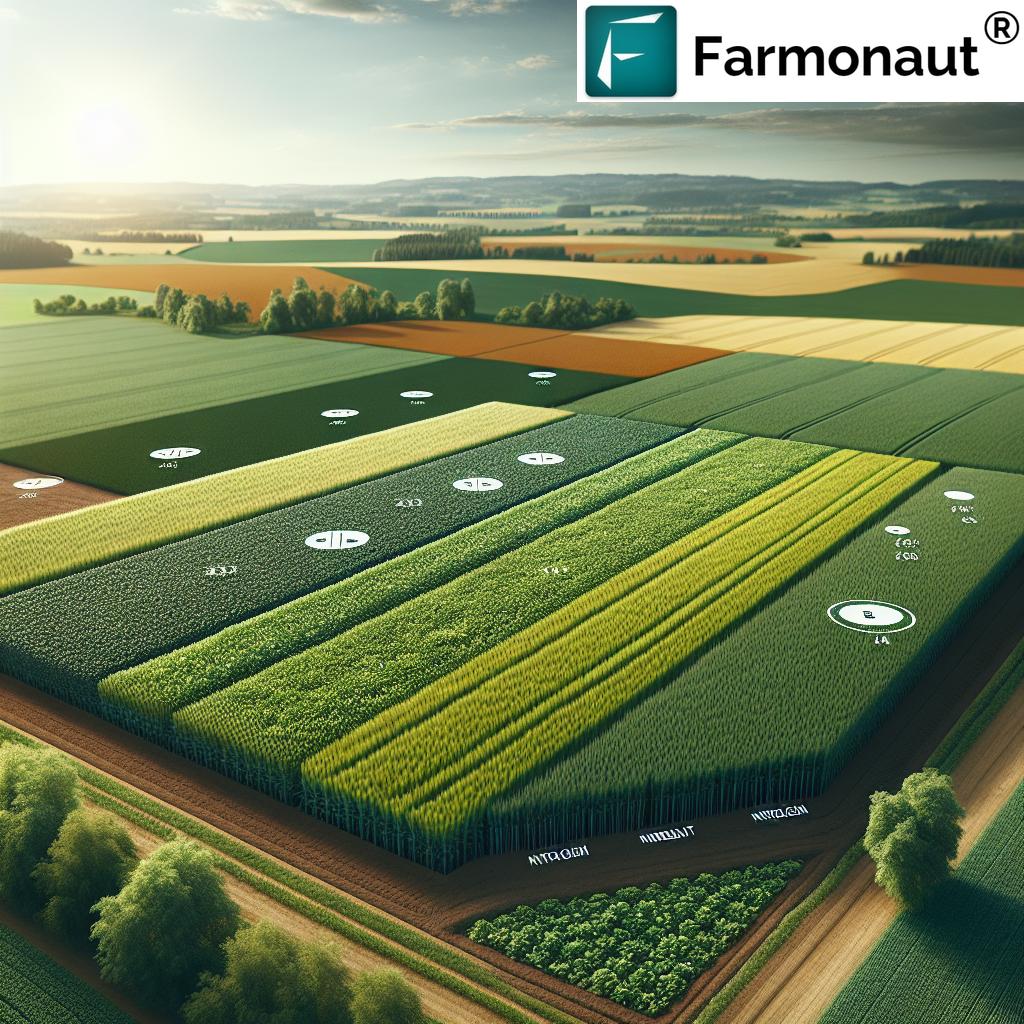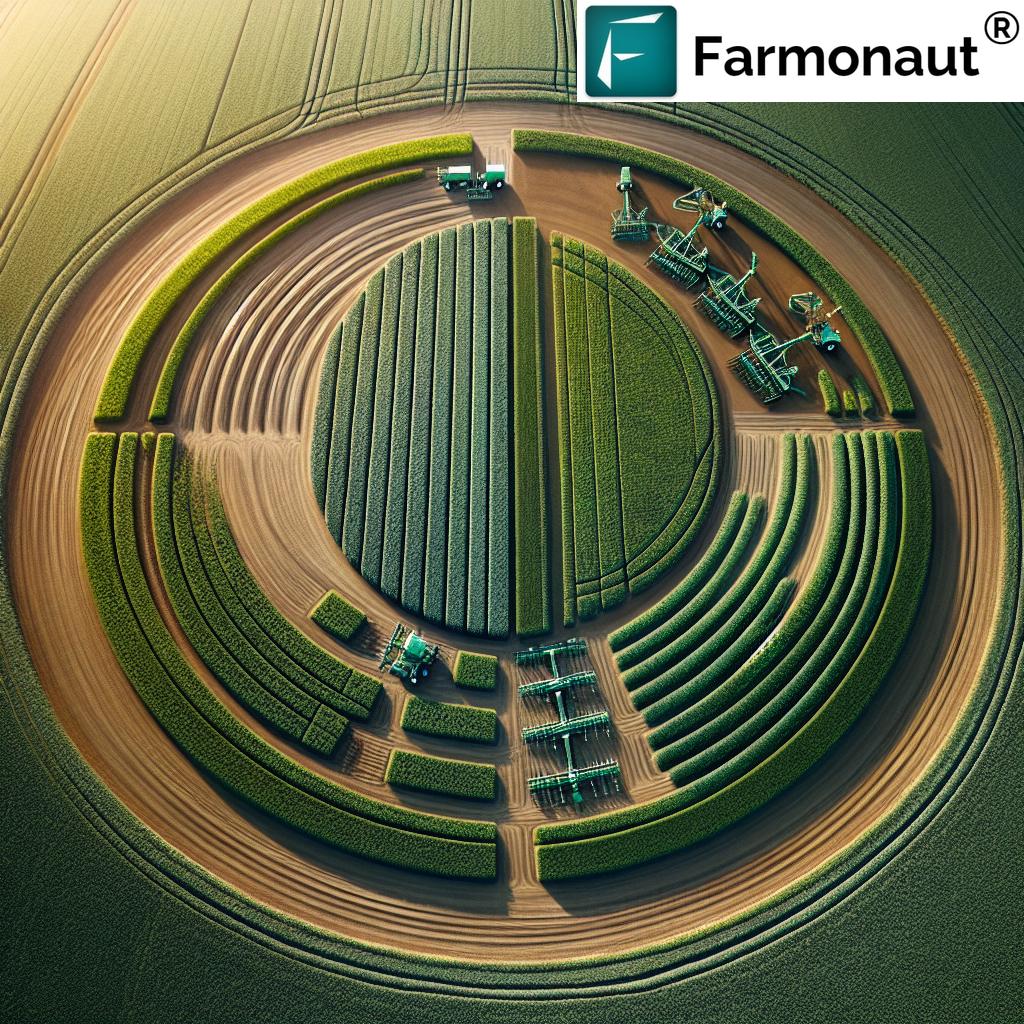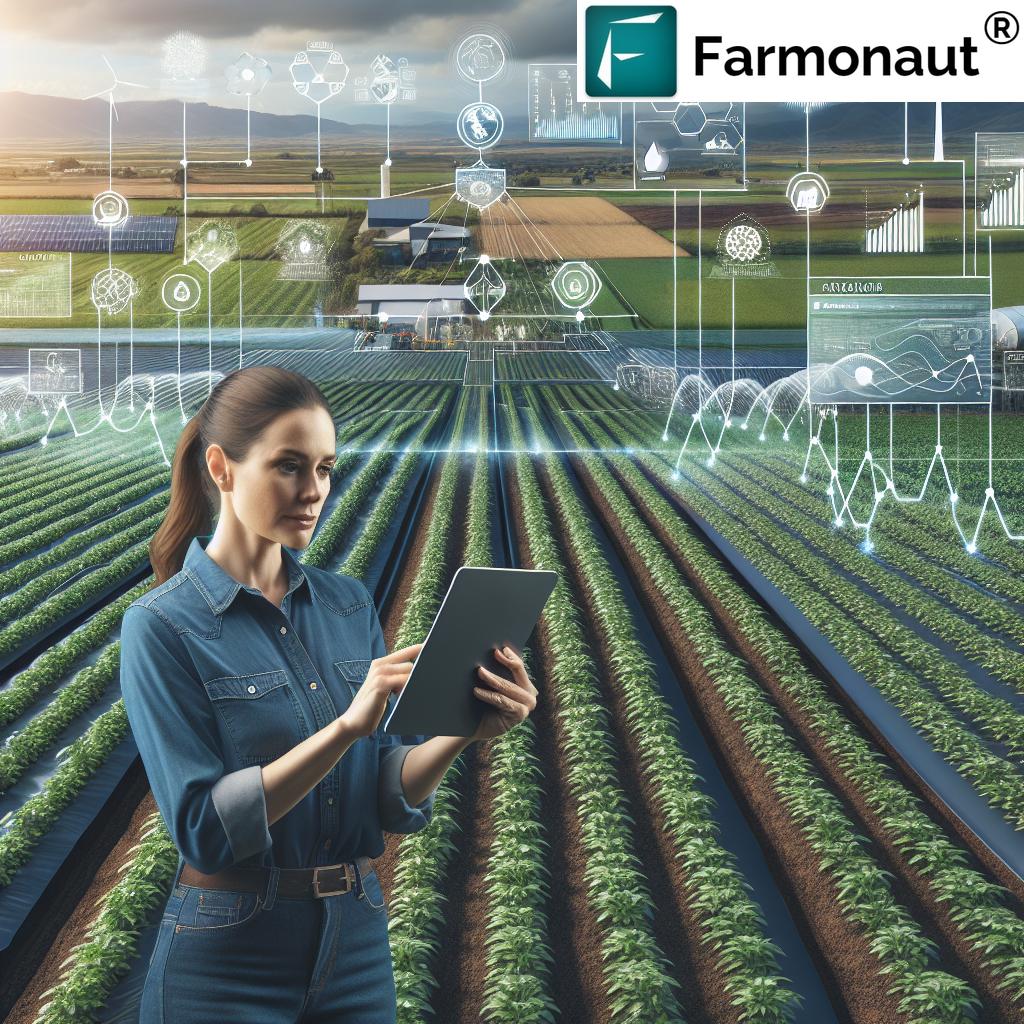Table of Contents
- Introduction
- Top 10 Smart Farm Innovations
- 1. Precision Agriculture & Satellite-Based Monitoring
- 2. Smart Irrigation Systems
- 3. Controlled Environment Agriculture (CEA)
- 4. Agrivoltaics: Solar Energy Integration
- 5. Agricultural Robotics
- 6. Agricultural Drones
- 7. Blockchain in Agriculture
- 8. Nanotechnology in Farming
- 9. Automated Irrigation Systems
- 10. AI in Agriculture
- Supporting Technologies & Sustainable Practices
- Top 10 Smart Farm Innovations: Features & Impact
- Challenges & Considerations
- Farmonaut: Smart Agriculture Solutions
- FAQ: Smart Farm Innovations & Agriculture Technology
- Conclusion
Agriculture Technologies: 10 Shocking Smart Farm Innovations
“Precision agriculture can increase crop yields by up to 20% while reducing fertilizer use by 10%.”
Over the past few decades, the world of agriculture has experienced transformative technological advancements, fundamentally reshaping how we, as farmers and stewards of the land, grow food and manage natural resources. The confluence of precision agriculture, smart irrigation systems, AI in agriculture, and sustainable practices is revolutionizing farming practices, empowering us to feed a growing global population with greater resource efficiency and minimal environmental impact.
At the heart of these innovations lies our dedication to sustainable farming practices—leveraging technology to optimize productivity, protect the soil and water, and ensure the long-term health of our crops and ecosystems. In this blog, we explore 10 shocking smart farm innovations making agricultural history, driven by disruptive technologies, data analytics, smart sensors, and the relentless pursuit of sustainable crop yields.
Top 10 Smart Farm Innovations
As modern farmers, we now have access to an exciting toolkit—encompassing everything from GPS-enabled mapping to machine-learning algorithms—putting the future of food security and sustainable agriculture within our reach.
1. Precision Agriculture & Satellite-Based Monitoring
Precision agriculture is arguably one of the most transformative trends in farming. By combining GPS, soil and weather sensors, satellite imagery, and advanced data analytics, we can monitor our fields with unprecedented detail. Precision ag enables us to create high-resolution maps of our fields, pinpointing variations in soil health, crop growth, moisture levels, and nutrient concentrations.
- Targeted management: Instead of blanket applications, we use sensors and digital tools to determine the exact amount of fertilizer, pesticides, or water each area of our field needs—reducing waste, costs, and environmental impact.
- Data-driven insights: Platforms like Farmonaut empower us with real-time crop health monitoring via satellite imagery and vegetation indices (e.g., NDVI, soil moisture, weather analytics), making precision agriculture actionable and affordable for every farmer.
- Resource optimization: By overlaying historical yield data, topography, and weather trends, we allocate our resources where they’re needed most, boosting efficiency and sustainability.
Today, precision agriculture isn’t just for large commercial farms—satellite-based crop monitoring services, like those from Farmonaut, bring affordable precision farming solutions to smallholder farmers globally, democratizing advanced farm management and unlocking higher productivity.
2. Smart Irrigation Systems
“Smart irrigation systems can save farmers up to 50% of water compared to traditional methods.”
Water scarcity is a critical concern for global agriculture, and smart irrigation systems are a game-changer. These advanced solutions use soil moisture sensors, weather data, and automated controls to optimize irrigation schedules.
- Soil and crop monitoring: Sensors embedded in the soil continuously monitor moisture levels and relay this data to automated controllers.
- Weather-based adjustments: By factoring in weather forecasts, these systems predict evapotranspiration rates and adjust watering cycles to minimize over- or under-watering.
- Remote management: Many smart irrigation platforms offer mobile apps or dashboards, letting us fine-tune water delivery—from any location and at any time.
By minimizing water waste and maximizing resource use, smart irrigation systems can lower consumption by up to 50% in some cases, especially when combined with drip or precision sprinkler irrigation methods. Platforms that incorporate resource management and remote irrigation controls offer us actionable tools to conserve water in even the most challenging environmental conditions.
3. Controlled Environment Agriculture (CEA)
Controlled Environment Agriculture (CEA) encompasses a wide range of innovative practices, including indoor farming, hydroponics, aquaponics, and vertical farming. By managing temperature, humidity, CO₂ levels, and light, we can produce crops year-round regardless of outdoor weather conditions.
- Vertical farming: Stacking crops in tiers, maximizing urban space and minimizing land usage.
- Hydroponics & Aeroponics: Using nutrient-enriched water (hydroponics) or misting (aeroponics) instead of soil, cutting water usage by up to 90% and slashing fertilizer and pesticide inputs.
- CEA benefits: Greater crop yields, smaller environmental footprint, lower transportation costs, and more consistent food quality.
Controlled environment agriculture empowers us to optimize every aspect of plant growth and resource efficiency, offering a powerful response to climate variability and the challenges of sustainable food production in both urban and rural settings.
4. Agrivoltaics: Integrating Solar Energy & Agriculture
Agrivoltaics is a groundbreaking practice that integrates solar panels with crop production, enabling dual land use: generating renewable energy while cultivating crops.
- Microclimate optimization: Elevated solar panels provide partial shade, reducing heat stress on crops and helping maintain adequate soil moisture and cool temperatures in arid regions.
- Resource and land efficiency: By combining energy production with agriculture, we maximize the value of farmland—reducing competition for space and contributing to overall sustainability goals.
- Reduced costs: On-farm solar power can offset electricity costs for irrigation and automated systems.
The synergy between farming and solar energy not only enhances land productivity but also supports the broader shift towards carbon footprint tracking and net-zero agriculture.
5. Agricultural Robotics
Agricultural robotics bring forth a new era of automation, with robots revolutionizing repetitive or labor-intensive tasks such as planting, harvesting, weeding, and crop monitoring.
- Autonomous efficiency: Robots equipped with machine vision and sensors can navigate fields, identify pests, diseases, or weeds, and perform interventions (like targeted herbicide application or robotic weeding) with pinpoint accuracy.
- Cost and labor savings: Automated machines operate tirelessly, reducing dependency on seasonal labor and lowering operational costs.
- Precision interventions: By focusing only on affected crops or soil areas, robotic solutions minimize excessive inputs and environmental impacts.
Robotic innovations propel agriculture into a future of streamlined, resource-conscious crop management, with major startups and research groups focusing on scalable solutions suitable for diverse farming environments.
6. Agricultural Drones
Drones have rapidly advanced from hobby-grade gadgets to indispensable tools for modern agriculture. Agricultural drones are equipped with high-resolution cameras, multispectral sensors, and powerful AI-driven analytics that allow us to:
- Survey fields: Rapidly cover large agricultural areas, mapping crop health, soil variations, and plant density.
- Detect problems: Drones can monitor crops for early signs of diseases, pests, or nutrient deficiencies, enabling us to quickly intervene and prevent major yield losses.
- Precision spraying: Some advanced drones can deliver pesticides, fertilizer, or even biological controls to targeted plants or problem spots, reducing overall chemical usage.
Farmonaut integrates drone and satellite monitoring APIs to help developers and businesses harness aerial data for their own farm management systems. These satellite, drone, and IoT-powered insights are transforming field scouting and operational decision-making.
7. Blockchain in Agriculture
Ensuring traceability, transparency, and trust in the agricultural supply chain has never been more important. Blockchain technology in agriculture offers a secure, immutable ledger for recording each step of a crop or product’s journey:
- Transparent supply chains: Every transaction, from planting and harvesting to distribution and sale, can be tracked, helping quickly detect contamination sources or fraudulent practices.
- Increased trust: Consumers and retailers gain confidence through blockchain-verified data, and farmers can certify the authenticity of their products.
- Streamlined compliance: Governments and industry bodies can verify standards for food safety, organic certification, or fair labor practices with minimal bureaucracy.
Discover how Farmonaut traceability solutions leverage blockchain for end-to-end visibility in modern agricultural supply chains, bolstering food safety and market access, especially for exporters and premium crop producers.
8. Nanotechnology in Farming
Nanotechnology in agriculture harnesses nanoscale sensors and materials to transform how we monitor and manage the health of soil, plants, and water resources:
- Nanosensors: Tiny devices, such as graphene-based sensors, can be deployed to detect nutrient levels, soil pH, moisture, or contaminants, in real time.
- Precision interventions: Nano-fertilizers and smart delivery systems allow the targeted release of nutrients or pesticides only where and when crops need them most.
- Disease and stress detection: Early identification of pathogens or toxins ensures that interventions can be timely and minimal, protecting both yield and environmental health.
The integration of nanotechnology in farming is opening up new markets for real-time, in-field diagnostics and resource optimization—paving the way for even finer control over sustainable agricultural practices.
9. Automated Irrigation Systems
Building on smart irrigation, automated irrigation systems employ sensors, data analytics, and AI to manage water delivery with minimal human intervention:
- Soil and weather sensors: Constantly monitor moisture at root-level and factor in current weather conditions and crop stage.
- Remote controls: Farmers can program or remotely adjust irrigation based on real-time data, thereby minimizing water waste.
- Examples: Drip irrigation, center-pivot systems, and automated micro-sprinklers controlled via smartphone or desktop.
Automated irrigation integrates seamlessly with large-scale farm management platforms, ensuring consistency across multiple fields and reducing labor while maximizing water use efficiency.
10. AI in Agriculture: Predictive Analytics, Automation & Learning
Artificial Intelligence (AI) and Machine Learning are at the vanguard of agricultural change. By processing huge volumes of data—from satellite imagery and historical weather data, to IoT sensor streams and drone footage—AI-powered systems drive a new level of predictive intelligence in farming:
- Yield forecasting: Algorithms predict yields and crop growth based on evolving conditions, helping us plan operations, logistics, and sales more efficiently.
- Disease/pest detection: AI models identify outliers and anomalies in crop health, enabling timely and targeted interventions before issues escalate.
- Resource allocation: By simulating different scenarios, AI decision-support recommends optimal water, fertilizer, and pesticide usage to maximize sustainability and margin.
Discover how Farmonaut’s Jeevn AI advisory system offers personalized, real-time insights to every farmer, enhancing productivity and crop health management through data-driven, context-aware advice.
“Smart irrigation systems can save farmers up to 50% of water compared to traditional methods.”
Supporting Technologies & Sustainable Practices
-
Genetic Engineering & Biotechnology:
Modern (genetic engineering) and biotechnology methods allow us to produce crops that are drought-tolerant, pest-resistant, or require less fertilizer, directly supporting sustainable farming. -
IoT (Internet of Things) in Agriculture:
IoT devices collect and send real-time data from every corner of the farm, including weather stations, soil moisture probes, and machinery. This continuous flow of information enables us to react proactively—detecting issues, optimizing resource usage, and better managing ongoing operations. -
Renewable Energy in Agriculture:
The integration of renewable solar and wind power reduces reliance on fossil fuels, powering automated systems, irrigation, and even robotics while shrinking the farm’s carbon footprint.- Farmonaut’s carbon footprint tracking lets agribusinesses monitor emissions in real time and move toward climate-resilient, sustainable operations.
-
Sustainable Practices:
Techniques like crop rotation, conservation tillage, and organic farming are being revitalized and supercharged by the above technologies, yielding more nutritious food and healthier soils for the next generation.
Top 10 Smart Farm Innovations: Features & Impact
| Innovation Name | Description | Key Technology Used | Estimated Yield Improvement (%) | Estimated Resource Savings (%) | Sustainability Impact |
|---|---|---|---|---|---|
| Precision Agriculture | Data-driven field management and targeted input application | GPS, Satellite Imagery, Sensors, Analytics | 15–20% | 10–15% (fertilizer) | Reduces waste, supports sustainable farming |
| Smart Irrigation Systems | Automated, sensor-based irrigation with weather integration | Moisture Sensors, IoT, Weather Data | 10–15% | 30–50% (water) | Closes water gap, prevents overuse |
| Controlled Environment Agriculture (CEA) | Indoor/vertical growing systems for year-round production | Hydroponics, Aeroponics, LEDs, Climate Control | Up to 200% (depending on crop) | Up to 90% (water) | Urban food resilience, space efficiency |
| Agrivoltaics | Dual use of land for solar energy and crops | Solar Panels, Mounting Structures | Up to 15% | Energy offset; varies (water savings in shade) | Renewable energy, climate adaptation |
| Agricultural Robotics | Automated machinery performs field tasks | Robots, Machine Vision, AI | 10–15% | Reduces labor and input usage | Lowers emissions, reduces chemical use |
| Agricultural Drones | Aerial surveying, disease scouting, & variable spraying | Drones, AI, Sensors | 10–20% | 5–20% (input use avoided) | Timely intervention, input savings |
| Blockchain in Agriculture | Transparent, secure record-keeping for supply chains | Blockchain Ledger, APIs | Indirect (market access, reduced losses) | Enhances consumer trust | Food safety, fraud reduction |
| Nanotechnology in Farming | Nano-sensors and smart materials for monitoring & delivery | Nanosensors, Nano-fertilizers | 5–10% | 10–20% (nutrients & water) | Less runoff, real-time decision making |
| Automated Irrigation Systems | Sensor-driven, remotely controlled water delivery | IoT, Remote Valves, Data Analytics | 10–15% | 30–50% (water) | Drought resilience, water savings |
| AI in Agriculture | Predictive analytics & resource optimization algorithms | Machine Learning, AI, Data Platforms | 10–20% | 10–20% (inputs), lower losses | Maximizes resource use, lowers emissions |
Challenges & Considerations
- Initial Cost & Technical Complexity: While smart farm innovations boost yields and resource efficiency, there is often a steep upfront investment in equipment, training, and technical support.
- Skill Gap: Developing the required know-how for operating, maintaining, and interpreting data from advanced technologies is a hurdle—especially for rural or smallholder farmers with limited access to training or digital literacy initiatives.
- Connectivity: Consistent, reliable internet and mobile connectivity is crucial for IoT, blockchain, and cloud-based systems. Bridging the digital divide is essential for equitable adoption.
- Security & Privacy: As farms become more data-driven, protecting sensitive information and equipment from cyber threats is paramount.
We must collaboratively address these challenges, ensuring smart agriculture is inclusive, secure, and practical for farms of every size and region.
Farmonaut: Empowering Precision Agriculture & Smart Farm Innovations
At Farmonaut, we understand the pressing need for affordable and accessible precision agriculture—not just for large enterprises, but for every grower, agribusiness, cooperative, and government committed to sustainable farming.
-
Satellite-Based Crop Health Monitoring:
We bring precision agriculture to life with accurate, satellite-derived insights about crop vigor, soil moisture levels, and impending weather events, enabling you to monitor and manage fields efficiently via our Android, iOS, and web app. -
Jeevn AI Advisory System:
Our AI-powered platform provides personalized, actionable advice for crop, soil, and irrigation management—optimizing productivity and minimizing waste. -
Blockchain-Based Traceability:
Seamlessly integrate blockchain in agriculture to assure food safety, origin authenticity, and compliance across your supply chain. -
Fleet and Resource Management:
Our advanced tools for fleet management and logistics help agribusinesses maximize vehicle and machine efficiency across large landholdings. -
Carbon Footprint Tracking & Sustainability Analytics:
Leading the way in carbon accounting for agriculture, we provide compliance-ready sustainability metrics to help your operation go green. -
API for Developers & Business Integrations:
Supercharge your custom farm tech stack with satellite, crop, and weather data through our API (get started with developer docs here). -
Crop Loan and Insurance Verification:
Secure loans and insurance efficiently with satellite-based verification and reduce risk of fraud.
FAQ: Smart Farm Innovations & Agriculture Technology
What is precision agriculture and why is it important?
Precision agriculture uses satellite imagery, sensors, and analytics to apply the right inputs (water, fertilizer, pesticides) at the right place and time. This reduces waste, increases yields, minimizes environmental impact, and makes farming more profitable and sustainable.
How do smart irrigation systems help save water?
Smart irrigation systems monitor soil moisture, weather, and crop needs in real time. They automate water delivery, reducing unnecessary watering by up to 50% compared to traditional irrigation methods, especially vital in water-scarce regions.
What role does AI play in agriculture?
AI analyzes big data from satellites, drones, IoT devices, and past cropping results to predict yields, track diseases or pests, and recommend optimal management practices. AI boosts efficiency, lowers risk, and helps farmers make smarter, proactive decisions.
How is Farmonaut different from traditional farm management platforms?
Farmonaut provides affordable, satellite-based precision ag tools—no expensive hardware needed. With crop health monitoring, blockchain-based traceability, carbon footprinting, and personalized AI advisory, it’s a one-stop solution for all types of farmers and agri-enterprises.
Can small and medium farmers benefit from smart farm innovations?
Absolutely. Most smart technologies (especially satellite-based monitoring, mobile apps, and automated systems) are scalable and affordable for farms of all sizes. Farmonaut’s flexible pricing and API options mean everyone can access the benefits of data-driven agriculture.
How secure is data collected by agricultural technologies?
Security and privacy are top priorities. Advanced platforms utilize encryption, secure authentication, and data anonymization to protect user and farm information. Blockchain-based traceability also ensures record integrity.
Where can I learn more or try these technologies?
Try Farmonaut’s platform by downloading the Android or iOS app, or access via web browser. Developers can integrate our data via API.
Conclusion: A Future Beyond Traditional Agriculture
The integration and evolution of smart farm innovations—from precision agriculture to AI-driven analytics—represent a historic leap in our ability to sustainably feed the global population. As these technologies mature, their positive impact on crop yields, resource efficiency, food safety, and environmental protection becomes ever more tangible.
By leveraging real-time monitoring, blockchain in agriculture, automated irrigation, advanced robotics, and interconnected IoT systems, we move towards a resilient, adaptive, and productive future. Progress is not only about technology itself, but also about empowerment—making these tools affordable, accessible, and practical for every farmer, everywhere.
Let’s embrace innovation, data, and sustainability as we cultivate smarter, greener, and more abundant farms—together.

